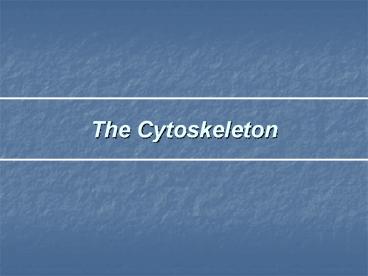The%20Cytoskeleton - PowerPoint PPT Presentation
Title:
The%20Cytoskeleton
Description:
The Cytoskeleton – PowerPoint PPT presentation
Number of Views:200
Avg rating:3.0/5.0
Title: The%20Cytoskeleton
1
The Cytoskeleton
2
Objectives
- Define cytoskeleton.
- Explain the general functions of the
cytoskeleton. - List the 3 types of cytoskeletal elements and
their respective functions. - Describe the structure and function of the
centrosome. - Describe the structure and functions of
centrioles - List and describe the similarities and
differences between cilia and flagella.
3
The Cytoskeleton
- Prior to 1970s cytosol thought to be unorganized
mix of organic molecules. - Electron microscopy reveals organized cytosol
- Immunoflourescence microscopy identified protein
fibers.
4
(No Transcript)
5
The Cytoskeleton
- Characteristics
- ? Found in eukaryotes
- ? Network of connected filaments and tubules
- ? Extends from nucleus to plasma membrane
- ? Elements can disassemble and reassemble
6
The Cytoskeleton
- Function
- ? Maintains cell shape
- ? Allows organelles to move
7
The Cytoskeleton
Composed of 3 Types of Filaments Actin Intermediat
e Microtubules
8
Actin Filaments
- Characteristics
- Long, thin about 7 micrometers in diameter
- Occur in bundles or meshlike networks.
- Consist of two chains of globular actin monomers
twisted to form a helix.
9
Actin Filaments
- Functions
- ? Structural
- Form dense complex web just under the plasma
membrane. - In microvilli of intestinal cells likely
shorten or extend cell into intestine. - In plant cells, they form tracks along with
chloroplasts circulate.
10
Actin Filaments
- Functions
- ? Movement
- Iinteracts with motor molecule myosin
- Similar action accounts for pinching off cells
during division and for amoeboid movement.
11
Intermediate Filaments
- Characteristics
- ? 8-11nm in diameter
- ? Rope-like
- ? Fibrous polypeptides
12
Intermediate Filaments
- Functions
- ? Support
- Nuclear envelope
- Plasma membrane
- ? Form cell-to-cell junctions.
13
Microtubules
- Description
- ? Ropelike, hollow cylinders (25nm in
diameter, 0.2 micrometers in length). - ? Composed of protein (Tubulin) alpha and
beta - ? Associated with motor molecules (kinesins)
kinesin and dynein
14
Microtubules
- Functions
- ? Maintain shape of cells
- ? Tracks for vesicle and organelle movement
- ? Different kinesins move different vesicles or
organelles.
15
(No Transcript)
16
(No Transcript)
17
Centrioles
- Short cylinders with a 90 pattern of
microtubules triplets. - Animals cells and most protista, two centrioles
lying at right angles - Plant and fungal cells have equivalent of a
centrosome but does not contain centrioles. - Centrioles serve as basal bodies for cilia and
flagella.
18
(No Transcript)
19
Centrioles
- Serve as basal bodies for cilia and flagella.
20
Cilia and FlagellaFlagella (L. flagello, whip) ?
Cilia (L. cilium, eyelash, hair)
- Short, usually numerous hair like projections
that can move in an undulating fashion.
21
(No Transcript)
22
Differences
- Flagella longer than cilia, usually fewer
- Flagella are whip-like projections
- Flagella move whip-like (e.g. Sperm cells),
cilia move swimmer-like/oar-like
23
(No Transcript)
24
Similarities
- Construction
- Membrane-bounded cylinders
- (92 pattern of micortubules).
- Basal bodies
- Movement
- Microtubules slide past one another.
25
Similarities(Contd)
- Growth
- By addition of tubulin to tips
- Movement Mechanism
- Microtubules slide past one another.
26
Review
- Define cytoskeleton.
- Explain the general functions of the
cytoskeleton. - List the 3 types of cytoskeletal elements and
their respective functions. - Describe the structure and function of the
centrosome. - Describe the structure and functions of
centrioles - List and describe the similarities and
differences between cilia and flagella.































